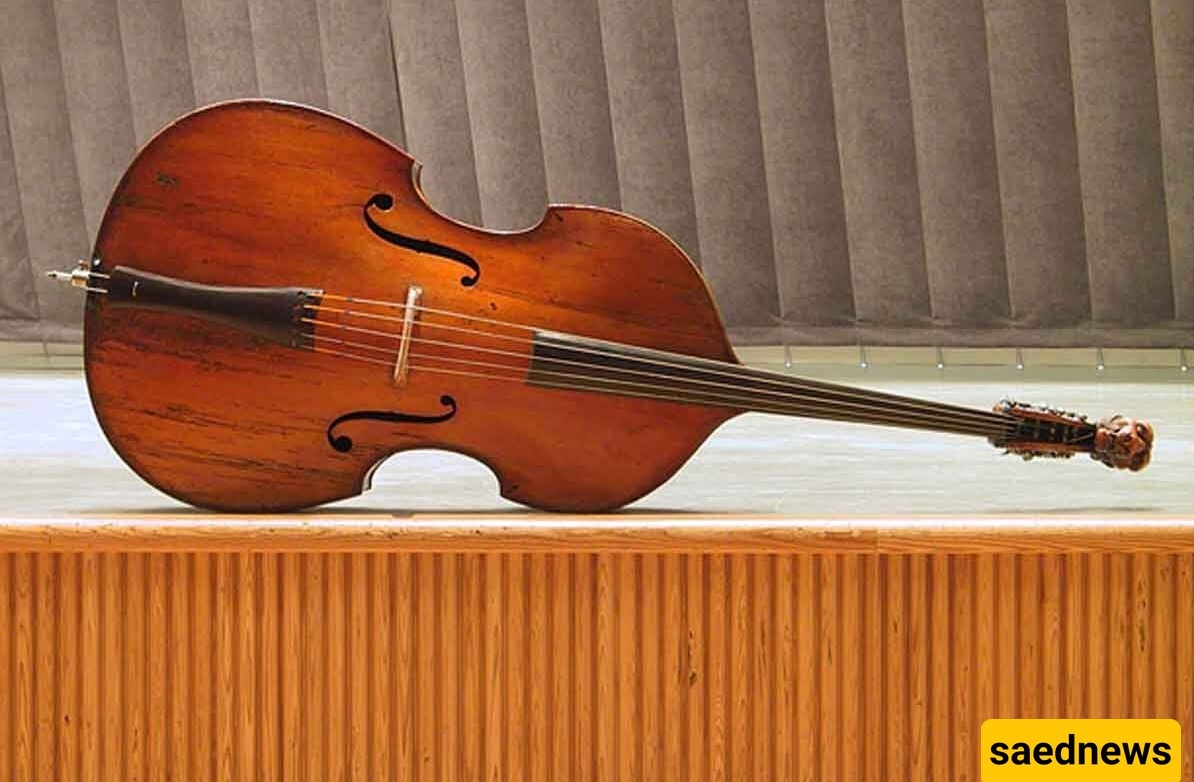The Double Bass is the largest and lowest-pitched bowed string instrument in the orchestra (after the octobass), played either with a bow or by plucking the strings (pizzicato). Today, this instrument plays an important role in the string section of Western classical music orchestras.

These are instruments that have strings in their construction and are played with a bow (arche). In the violin family, you can find instruments of different sizes, each with its own name and unique features. The violin family instruments, from highest to lowest pitch, are: violin, viola, cello, double bass, and so on. In this article, we intend to introduce you to the double bass. Please stay with us until the end.
This instrument is the largest and lowest-pitched member of the bowed string family. Its appearance is somewhat different from the previous three instruments (violin, viola, cello). Specifically, the upper part of the body’s outer wall is not rounded like the others but curves in the opposite direction, somewhat tangent to the neck. The back surface of the double bass is also flat rather than arched, unlike the other three instruments. Another difference is that today the double bass strings are tuned in intervals of fourths. Additionally, the instrument sounds an octave lower than the written notes. The 4th and 5th strings (if present) are tuned a third apart. Some double basses have four strings tuned as mentioned, but the lowest string (E) can be mechanically lowered a major third (to a C note) using a special device on the instrument and then raised back to E. In the 19th century and before, double basses typically had three strings.
The double bass is the largest and lowest-pitched bowed string instrument, played either with a bow or by plucking (pizzicato). Today, this instrument plays an important role in the string section of Western classical orchestras. The double bass is used not only in Western classical music but also in other genres such as jazz, blues, and rock and roll.
The strings are tuned from lowest to highest as follows: G (1st string), D (2nd string), A (3rd string), and E (4th string). The double bass is the largest instrument in the bowed string family, so the player places the instrument on the ground and plays it while standing.
As mentioned, the double bass is the largest and lowest-pitched bowed string instrument with four strings. However, in many modern orchestras, at least two or three double basses have five strings (an additional string tuned to C or B).
The role of this instrument in the orchestra is not only to provide weight and power in the bass section but also to provide the rhythmic foundation. The double bass is also used as a basso continuo (a bass line played continuously throughout a piece, often indicated by bass notes with figures below them to specify intervals and chords).
Solo and concerto pieces for the double bass are rare, partly due to its limited acoustic projection in large halls.
Double bass solos usually sound weak and distant, but a group or section of double basses can sound strong and clear. In solo performances, the double bass is usually tuned a half step higher to produce a clearer and brighter tone.
The double bass is the largest instrument in the bowed string family.
It has the lowest pitch range among bowed string instruments.
The strings are tuned from lowest to highest as: G (1st), D (2nd), A (3rd), and E (4th).
Double bass strings are tuned in fourths, opposite to violin strings.
The instrument sounds one octave lower than the written notes.
Its music is written in bass clef on the fourth line.
It usually has four strings, but five-string versions exist, capable of playing four notes lower than the four-string model.
The tuning is in perfect fourths, with the first string tuned to the lowest pitch.
Various forms of the double bass date back to the 15th or early 16th century and were commonly used until the 18th century. Ludwig van Beethoven and later composers emphasized the importance of the double bass in the symphony orchestra. Beethoven’s friend Domenico Dragonetti and conductor Serge Koussevitzky were skilled double bass players who composed concertos for the instrument.
In jazz ensembles, the bass is part of the rhythm section and is also used as a melodic instrument. It is often amplified electronically in such groups. A smaller, more portable version called the “upright bass” is common. In many rock and jazz bands, the electric bass guitar is used instead of the double bass.

Summary
The double bass or upright bass is the largest and lowest-pitched bowed string instrument, played with a bow or by plucking (pizzicato). Classified as a chordophone, it belongs to the lute family of string instruments and is part of the violin family (violin, viola, cello). Today, the double bass plays an important role in the string section of Western classical orchestras.

